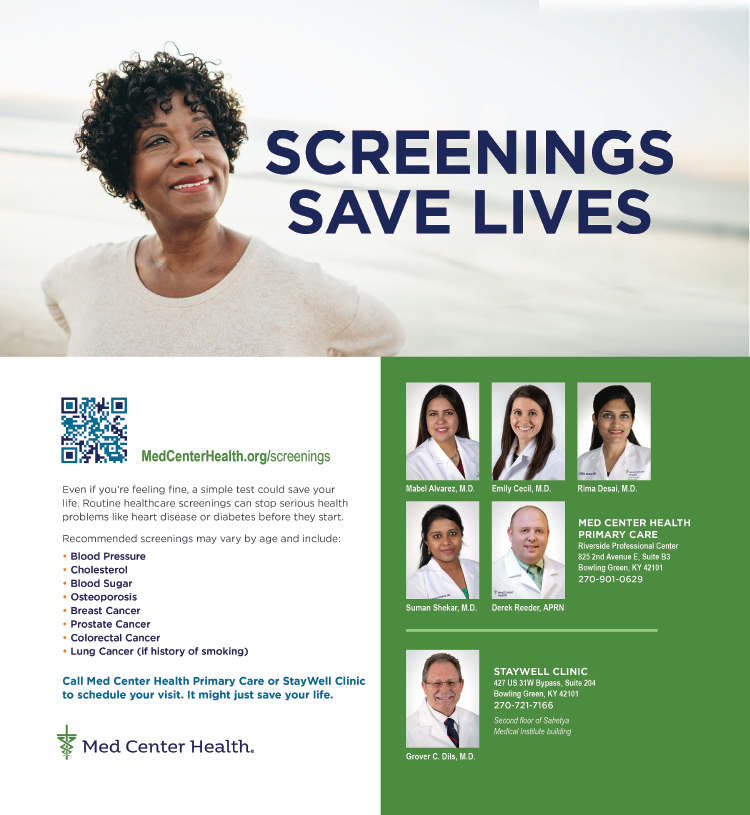
Do you have pain in your legs while walking that only gets better when you stop moving? Do your toes feel cold all the time? If so, you may need to talk to your doctor about screening for peripheral arterial disease (PAD).
PAD is caused by a narrowing or blockage of the blood vessels in your legs. It’s usually caused by atherosclerosis – a buildup of fatty plaques in the arteries. Any blood vessel can develop PAD, but it’s most often found in the arms and legs. Having PAD can increase your risk for heart attack or stroke.
“Leg or arm pain with exercise should not be considered a normal part of aging,” said Magendran Danapal, M.D., with Med Center Health Heart, Lung and Vascular Surgeons. “PAD can deprive the limbs of oxygen, glucose and other nutrients. If the disease is severe, you may have pain at night or sores that will not heal. These are very concerning signs, and it is important to consult with a vascular surgeon to prevent loss of limb in those cases.”
The Centers for Disease Control and Prevention (CDC) estimates almost 6.5 million people in the U.S. who are age 40 and older have PAD. African Americans have an increased risk, and Hispanics have a slightly higher risk than non-Hispanic whites.
Risk factors include things you can control, but also some things that you can’t, such as your age:
•Smoking
•High blood pressure
•Atherosclerosis
•Diabetes
•High cholesterol
•Age above 60 years
While leg pain that goes away with rest is the most common symptom, about four in 10 people with PAD don’t experience pain at all. There are other signs. You might have weakness in your legs, hair loss, shiny skin or skin that is cool to the touch, lack of pulses in your feet and sores that don’t heal on your legs and feet. You might also have numb or cold toes. All of these are because of the lack of circulation caused by the narrowing of blood vessels.
“The severity of condition determines treatment,” Dr. Danapal said. “Many people are able to make lifestyle changes and use medication to control cholesterol, diabetes and hypertension. In more severe cases, minimally-invasive angioplasty – which is surgical repair or unblocking of the blood vessel – or even open bypass surgery may be required.”
The best way to prevent PAD is through lifestyle. Get plenty of exercise, don’t smoke and keep blood pressure and cholesterol under control. If you have diabetes, be sure to work with your doctor to make sure you keep your A1C within an acceptable range.
If you have symptoms of PAD, talk with your healthcare provider about being screened. They may order an ankle brachial index, which measures the blood pressure in your ankles compared to the blood pressure in your arms. They may also order imaging tests, including ultrasound, magnetic resonance angiography or computed tomographic angiography.
PAD can be treated by medication to avoid clots caused by PAD and to keep your cholesterol from being high. Surgery is sometimes needed to bypass blocked arteries. If you smoke, one of the best things you can do is to quit.
If you are at risk for PAD or other vascular disease, consider the non-invasive, painless screenings offered by Med Center Health that look for the most common vascular risks: Lower Extremity Peripheral Arterial Disease, Stroke and Aortic Aneurysm.
The cost is $35 for each screening or all three screenings for $90. For members of The Medical Center’s Senior Health Network, The Women’s Center or Men’s Health Alliance programs, the cost is $80 for all three. To learn more, visit MedCenterHealth.org/vascular-screenings.
-submitted by Med Center Health





